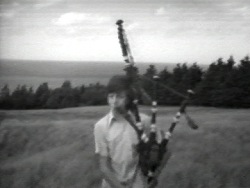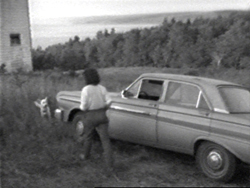Jonas addresses perceptual phenomena in the natural landscape and questions the camera's recording of reality. Here she ritualistically charts sound, space and time in the topology of landscape. A boy playing bagpipes emerges from behind the camera, circles a field and then returns to the camera.
Shot in rural Nova Scotia, Barking is infused with a sense of mystery, the anticipation that something is about to happen. Suggesting an off-screen narrative, the scenario carries an unsettling implication of the limit of vision and the power of what is not seen.
Description
In these two minimalist exercises, Jonas addresses perceptual phenomena in natural landscapes, and questions the camera's recording of reality. In Three Returns, she ritualistically charts sound, space and time in the topology of landscape. A boy playing bagpipes emerges from behind the camera, circles a field and then returns to the camera. Each successive "return" elicits the viewer's awareness of changes in the sound of the bagpipes and in the scale of the pasture. Barking is infused with a sense of mystery, the anticipation that something is about to happen. A car is parked outside a house in a rural Nova Scotia landscape. A dog barks into the distance. A woman enters the frame, looks for the object of the dog's barking, and leaves. The camera pans the landscape, revealing nothing. With its intimations of an off-screen narrative, this simple scenario carries an unsettling implication of the limit of vision and the power of what is not seen.

